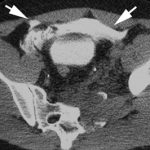Bladder injury is uncommon after blunt trauma. It is typically seen after high energy events, most commonly a motor vehicle crash with a lap belt in place. During the initial evaluation, the patient may complain of abdominal pain, but this is not universal.
FAST results are also inconsistent. Free fluid may be seen, and an irregular bladder outline may also be appreciated. The key to diagnosis is placement of a urinary catheter. Bloody urine is found nearly 100% of the time.
The character of the bloody urine suggests what type of injury is present. Faint hematuria, primarily shades of pink, is usually associated with renal injury or a bladder contusion. A moderate amount of darkly bloody urine is frequently associated with extraperitoneal bladder injury. A small amount of very dark, bloody urine may mean an intraperitoneal bladder injury. Finally, scant and very dark blood in the catheter suggests a urethral injury or a catheter balloon inflated in the urethra.
Examination of the urine is suggestive but not diagnostic of the type of injury. Determining the real diagnosis requires imaging, and evaluation of the entire GU tract is essential. CT scan is used to evaluate the kidneys, ureters, and to some degree, the bladder. Cystogram is required to fully evaluate the bladder, and a CT technique may be used. Bladder imaging using passive filling by clamping the catheter is accurate only 50% of the time. The bladder must be pressurized using contrast instilled into the bladder by gravity. When performed in this manner, the CT cystogram is 97% accurate.
Once a diagnosis of bladder injury is made, the treatment is usually straightforward. Extraperitoneal injuries usually do not require repair and will heal on their own. However, if the symphysis pubis needs instrumentation to restore anatomic position, concomitant repair of the bladder is frequently necessary to keep the hardware from being contaminated by urine.
Intraperitoneal injuries require operative repair. If possible, the injured area should be opened and the inside visually inspected. If the injury extends anywhere near the trigone, a urology consult should be obtained. Most repairs are simple two layer closures. The mucosal layer must be made with absorbable suture; the outer layer is surgeon’s choice.
For either type of bladder injury, the urinary catheter should be left in place for about 10 days. A cystogram should be obtained, and in most cases there will not be any leakage of urine and the catheter can be removed. In the event of a leak, another 7 days with the catheter is in order and the cystogram can be repeated.
The vast majority of bladder injuries can be easily handled by the trauma surgeon and are healed completely within two weeks.
Related posts:

